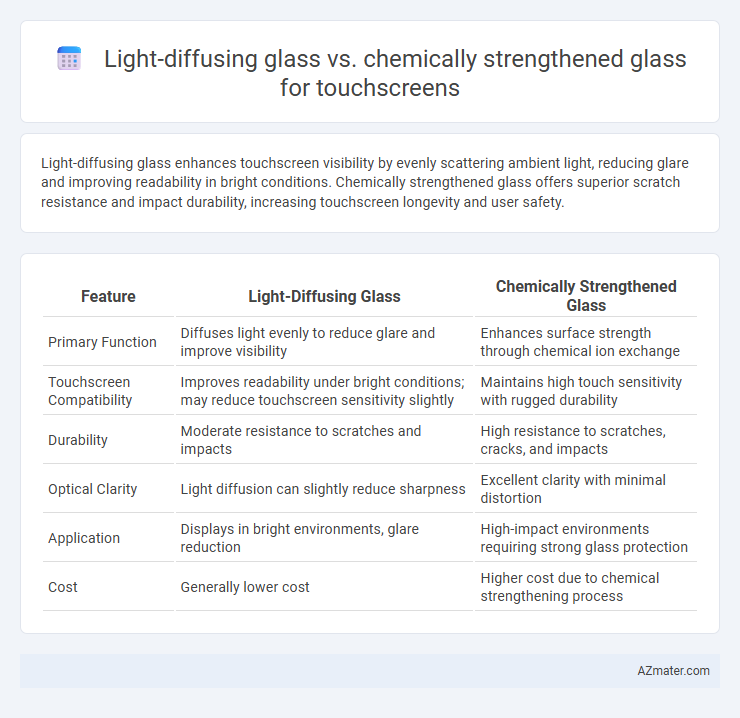Light-diffusing glass enhances touchscreen visibility by evenly scattering ambient light, reducing glare and improving readability in bright conditions. Chemically strengthened glass offers superior scratch resistance and impact durability, increasing touchscreen longevity and user safety.
Table of Comparison
| Feature | Light-Diffusing Glass | Chemically Strengthened Glass |
|---|---|---|
| Primary Function | Diffuses light evenly to reduce glare and improve visibility | Enhances surface strength through chemical ion exchange |
| Touchscreen Compatibility | Improves readability under bright conditions; may reduce touchscreen sensitivity slightly | Maintains high touch sensitivity with rugged durability |
| Durability | Moderate resistance to scratches and impacts | High resistance to scratches, cracks, and impacts |
| Optical Clarity | Light diffusion can slightly reduce sharpness | Excellent clarity with minimal distortion |
| Application | Displays in bright environments, glare reduction | High-impact environments requiring strong glass protection |
| Cost | Generally lower cost | Higher cost due to chemical strengthening process |
Introduction to Touchscreen Glass Technologies
Light-diffusing glass enhances touchscreen readability by scattering ambient light, reducing glare, and improving visibility under various lighting conditions. Chemically strengthened glass, such as tempered aluminosilicate, increases surface durability and scratch resistance through ion exchange processes, ensuring robust protection for touchscreens. These glass technologies optimize the balance between optical clarity and mechanical strength essential for high-performance touchscreen devices.
What is Light-Diffusing Glass?
Light-diffusing glass is engineered to scatter incoming light evenly across the touchscreen surface, reducing glare and enhancing visibility under various lighting conditions. This type of glass integrates microscopic particles or textured surfaces that prevent hotspots and improve user experience by maintaining screen clarity and color accuracy. Unlike chemically strengthened glass, which is designed primarily for durability and scratch resistance through ion exchange processes, light-diffusing glass focuses on optimizing optical performance for better display readability.
Overview of Chemically Strengthened Glass
Chemically strengthened glass for touchscreens undergoes an ion-exchange process that replaces smaller ions in the glass with larger ones, creating a compressive stress layer that enhances durability and resistance to scratches and impacts. This type of glass offers superior strength compared to light-diffusing glass, making it ideal for devices requiring robust protection without sacrificing clarity or touch responsiveness. Its enhanced toughness and scratch resistance contribute to longer lifespan and improved user experience in smartphones, tablets, and other touchscreen applications.
Optical Properties Comparison
Light-diffusing glass enhances touchscreen visibility by scattering light to reduce glare and improve readability under various lighting conditions, while maintaining high transparency. Chemically strengthened glass offers superior scratch resistance and durability but has minimal impact on light diffusion, preserving clarity without altering optical transmission. The choice between the two depends on balancing optical performance for visibility and physical protection against damage.
Durability and Scratch Resistance
Chemically strengthened glass offers superior durability and scratch resistance for touchscreens due to its ion-exchange process, which creates a compressive surface layer that resists cracks and abrasions effectively. Light-diffusing glass primarily enhances visual clarity and reduces glare but typically lacks the enhanced toughness of chemically strengthened variants, making it more prone to scratches under heavy use. For high-performance touchscreens requiring long-lasting durability and scratch protection, chemically strengthened glass remains the optimal choice.
Impact on Touch Sensitivity
Light-diffusing glass maintains high touch sensitivity by evenly scattering light without altering the capacitive touchscreen's responsiveness, ensuring accurate and smooth touch detection. Chemically strengthened glass enhances surface durability and scratch resistance through ion exchange but can slightly reduce touch sensitivity if the thickness or ion concentration affects the electric field detection. Optimizing thickness and ion treatment in chemically strengthened glass minimizes impact on capacitive sensing performance compared to the inherently more touch-sensitive light-diffusing glass.
Manufacturing Processes and Costs
Light-diffusing glass for touchscreens is manufactured through processes such as sandblasting or etching to create microstructures that scatter light, enhancing visibility and reducing glare, which increases production complexity and cost compared to standard glass. Chemically strengthened glass undergoes an ion-exchange process where smaller sodium ions are replaced with larger potassium ions in a high-temperature bath, significantly increasing surface strength and scratch resistance with a relatively streamlined and cost-effective manufacturing procedure. While light-diffusing glass demands more intricate surface treatments leading to higher material costs, chemically strengthened glass offers durability benefits at a lower incremental manufacturing expense, making it more cost-efficient for large-scale touchscreen applications.
Applications in Consumer Electronics
Light-diffusing glass enhances touchscreen visibility by reducing glare and improving readability under direct sunlight, making it ideal for smartphones used outdoors. Chemically strengthened glass offers superior durability and resistance to scratches and impacts, which is essential for high-use devices like tablets and wearables. Consumer electronics benefit from combining both technologies to deliver screens that are both visually accessible and highly resistant to damage.
Sustainability and Environmental Considerations
Light-diffusing glass enhances touchscreen visibility by scattering light, reducing the need for higher brightness levels and thereby lowering energy consumption. Chemically strengthened glass, created through ion exchange processes, offers superior durability that extends device lifespan and minimizes electronic waste. Both technologies contribute to sustainability, with light-diffusing glass promoting energy efficiency and chemically strengthened glass reducing replacement frequency and resource use.
Choosing the Right Glass for Touchscreen Devices
Light-diffusing glass enhances touchscreen visibility by scattering light, reducing glare and improving readability under various lighting conditions, making it ideal for outdoor and high-brightness environments. Chemically strengthened glass, such as Gorilla Glass, offers superior durability and scratch resistance through ion exchange processes that reinforce the surface, ensuring long-lasting protection against drops and impacts. Selecting the right glass involves balancing optical clarity with mechanical strength based on device use case, where light diffusion optimizes display visibility while chemical strengthening prioritizes device resilience.

Infographic: Light-diffusing glass vs Chemically strengthened glass for Touchscreen
 azmater.com
azmater.com